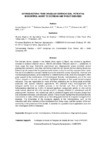Please use this identifier to cite or link to this item:
http://www.alice.cnptia.embrapa.br/alice/handle/doc/1037837| Title: | Actinobacteria from brazilian cerrado soil: potential biocontrol agent to soybean and wheat diseases. |
| Authors: | HOYOS, H. A. V.  CASTELIANI, A. G. B.   MORAIS, J. F. A.   CHIARAMONTE, J. B.   MELO, I. S. de   |
| Affiliation: | H. A. V. HOYOS, ESALQ/USP; A. G. B. CASTELIANI, ESALQ/USP; J. F. A. MORAIS, UNIP; J. B. CHIARAMONTE, ESALQ/USP; ITAMAR SOARES DE MELO, CNPMA. |
| Date Issued: | 2015 |
| Citation: | In: CONGRESSO BRASILEIRO DE MICROBIOLOGIA, 28., Florianópolis. Anais... Florianópolis: Sociedade Brasileira de Microbiologia, 2015. Ref. 1983-1. |
| Description: | Abstract: The Cerrado biome, located in the Middle West region of Brazil, has showed a significant increase in soybean (Glycine maxx L. Merrill) and wheat (Triticuma estivum L.) production. In these crops the fungi Sclerotinia sclerotiorum and Magnaphorte grisea constitute severe phytosanitary problems, once they commonly inhabit the soil favored by their latency structures. These fungi are responsible for great economic losses during the entirely crop production cycle. The soil is considered a complex habitat due to the extensive variety of physical, chemical and microbiological processes, and is essential for different forms of life, once this ecosystem offers great support to the maintenance of microbiological diversity. Actinobacteria, one of the main Phylum present in the soil, are currently highlighted because of their great biotechnological relevance. They are responsible for many of known antibiotics and by being great enzymatic producers with several industrial applications. We obtained many microorganisms with biological activity from an isolation process of the Cerrado soil. One of them was the Actinobacteria identified as 3-AS-4. It showed significant antagonistic activity in vitro and its crude extract, obtained with ethyl acetate at pH 3, strongly inhibited S. sclerotiorum and M. grisea growth. Moreover, this isolate was able to solubilize organic and inorganic phosphorus and presented chitinolytic and cellulolytic activity. These results highlight the broad and diversity mechanisms of action of this isolate as an interesting potential tool to integrate management of diseases. The knowledge of the ecological aspects of this Actinobacteria, such as the interaction with other members of the rhizosphere from these crops, and the variation of the soil community in the presence of this isolate, is essential to a possible future application as a new tool to biological control of diseases. |
| Thesagro: | Sclerotinia Sclerotiorum |
| NAL Thesaurus: | Biological control Actinobacteria |
| Keywords: | Magnaphorte grisea |
| Type of Material: | Resumo em anais e proceedings |
| Access: | openAccess |
| Appears in Collections: | Resumo em anais de congresso (CNPMA)  |
Files in This Item:
| File | Description | Size | Format | |
|---|---|---|---|---|
| 2015RA015.pdf | 60,76 kB | Adobe PDF |  View/Open |









